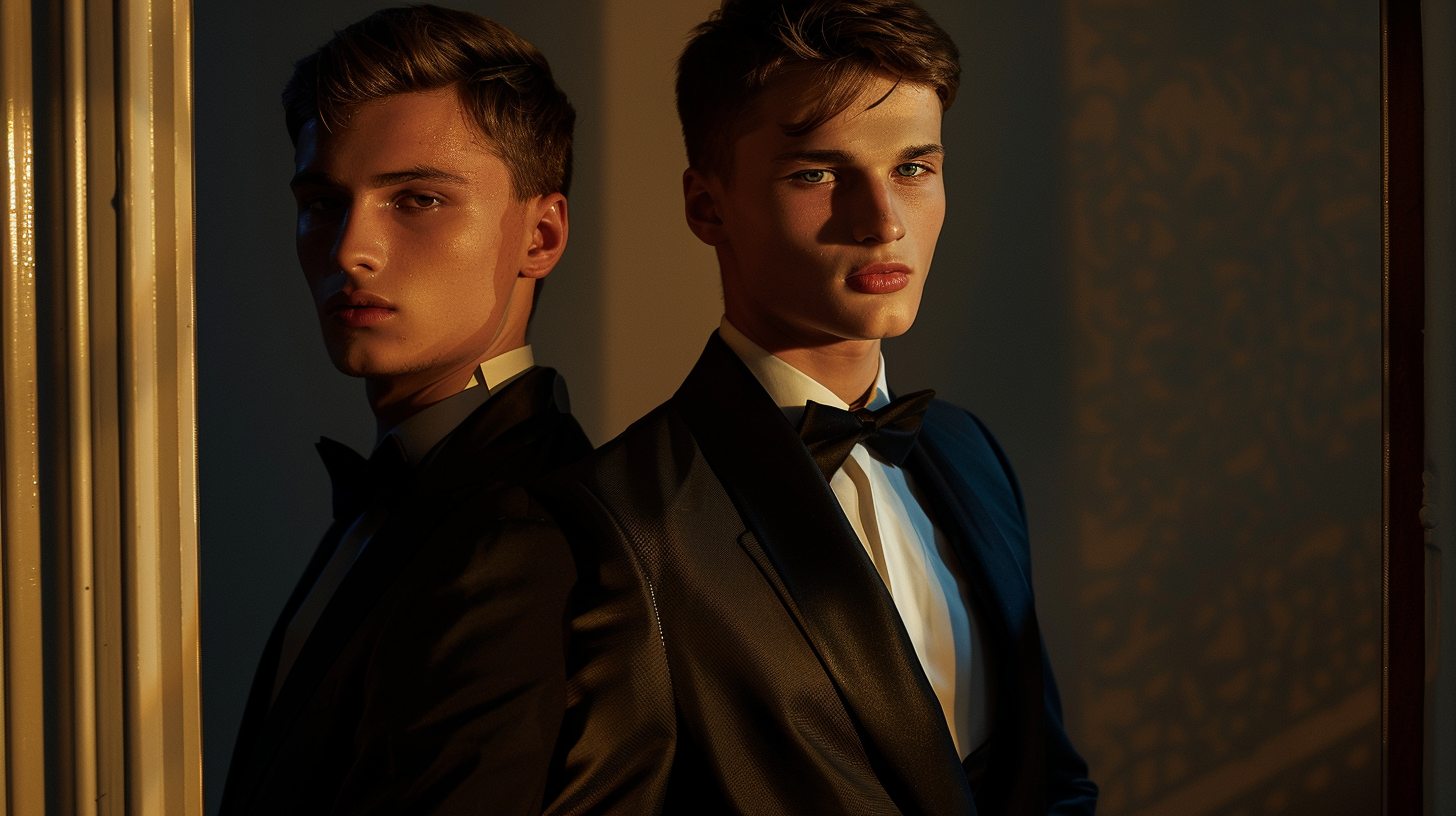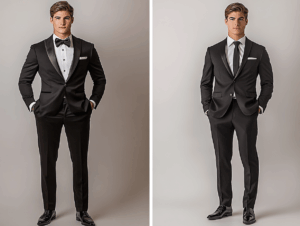Prom night is one of the biggest style moments for guys, and the big question is always the same—should you wear a suit or go all in with a tuxedo?
Both look sharp, but each carries its own level of formality, history, and vibe. A suit offers versatility and modern flair, while a tuxedo is built for pure elegance and black-tie tradition.
Knowing the difference helps you match your outfit to the event, your date’s look, and the impression you want to make. With the right choice, you’ll stand out confidently without ever looking out of place.
Read on to learn the key differences, the best times to wear each, and styling tips to make your prom outfit unforgettable.
Here’s What You’ll Learn:
- What makes them different – Understand the key style and formality differences between a suit and a tuxedo.
- When to wear a suit – See why suits work for prom, especially if you want a modern, versatile look.
- When to wear a tuxedo – Learn when a tuxedo is the smarter choice for a more formal, black-tie feel.
- How to match with your date – Simple tips to coordinate your outfit with your date’s dress without overdoing it.
- Style mistakes to avoid – Common errors that can make your outfit look mismatched or underdressed.
What Is a Suit?
A suit is a set of clothes made from the same fabric and meant to be worn together for a sharp, coordinated look. It typically includes a jacket and trousers, with the option of adding a vest for more formality. Suits are worn for business, weddings, and special occasions, with different styles, fabrics, and colors allowing them to fit many dress codes and personal tastes.
Types of Suit
Single-Breasted Suit
A single-breasted suit has one row of buttons and a narrow overlap of fabric. It is the most versatile style, suitable for business, weddings, and formal or semi-formal occasions.
Double-Breasted Suit
A double-breasted suit has two rows of buttons with a wider overlap of fabric. It creates a structured, bold look and is often chosen for more formal events.
Two-Piece Suit
A two-piece suit includes a jacket and matching trousers. It is the most common type, practical for professional settings, semi-formal events, and daily office wear.
Three-Piece Suit
A three-piece suit adds a vest to the jacket and trousers, giving a more refined and formal appearance. It is popular for weddings, black-tie events, and important business occasions.
Casual Suit
A casual suit is made from lighter fabrics like cotton or linen and often has a softer fit. It is ideal for outdoor gatherings, summer weddings, or events with a relaxed dress code while still looking polished.
What Is a Tuxedo?
A tuxedo is a formal suit distinguished by satin or silk details, most often seen on the lapels, buttons, and the side stripe of the trousers. Unlike regular suits, tuxedos are traditionally worn with a white dress shirt, a bow tie, and formal accessories like cufflinks and pocket squares. They are designed for black-tie events, weddings, galas, and other evening occasions where a higher level of formality is expected.
Types of Tuxedo
Single-Breasted Tuxedo
A single-breasted tuxedo has one row of buttons on the jacket and is the most common style. It offers a sleek, versatile look that works for weddings, galas, and most formal events.
Double-Breasted Tuxedo
A double-breasted tuxedo has two rows of buttons and a wider front overlap, giving a bold and classic appearance. It is less common but creates a strong statement for very formal occasions.
Peak Lapel Tuxedo
A peak lapel tuxedo features lapels that point upward, creating a sharp and formal look. It is considered one of the most traditional and elegant tuxedo styles, perfect for black-tie events.
Shawl Lapel Tuxedo
A shawl lapel tuxedo has smooth, rounded lapels that give a softer, refined appearance. This style is often chosen for evening wear and has a vintage, sophisticated appeal.
Notch Lapel Tuxedo
A notch lapel tuxedo has lapels with a small cutout where the collar meets the lapel. It looks closest to a regular suit and is considered the least formal tuxedo option, best for semi-formal or modern events.
Suit vs. Tuxedo: Key Differences 🤵🖤
Though they may look similar, suits and tuxedos have distinct features, uses, and levels of formality. Knowing the difference helps you dress appropriately for any occasion.
1. Fabric & Details 🧵
- Suit: Made from standard fabrics like wool, cotton, or blends, with simple buttons and lapels.
- Tuxedo: Features satin or grosgrain on the lapels, buttons, and sometimes a stripe on the pants for a formal, polished look.
2. Occasion 🎟️
- Suit: Suitable for business meetings, weddings, and semi-formal events.
- Tuxedo: Reserved for black-tie events, galas, and formal evening occasions.
3. Shirt & Accessories 👔
- Suit: Paired with a regular dress shirt, tie, or no tie for a smart-casual vibe.
- Tuxedo: Traditionally worn with a tuxedo shirt, bow tie, cufflinks, and formal studs.
4. Shoes 👞
- Suit: Dress shoes, loafers, or brogues work well.
- Tuxedo: Polished black patent leather or velvet loafers are preferred.
Bottom Line 💡
A suit is versatile and everyday-formal, while a tuxedo is specifically for evening elegance. Choosing the right one ensures you look sharp and appropriately dressed.
The History of the Suit 🧵🤵
The suit has evolved over centuries, transforming from a symbol of status to a wardrobe staple for men worldwide. Here’s a brief look at its journey:
1. 17th–18th Century: The Early Origins 🎩
Suits began as coordinated ensembles for European aristocracy. They featured long coats, waistcoats, and breeches, designed to display wealth and refinement.
2. 19th Century: The Birth of the Modern Suit 🧥
The Industrial Revolution and Victorian era brought tailored jackets, trousers, and vests in matching fabrics. The lounge suit emerged in England as a comfortable, everyday alternative to formal court attire.
3. Early 20th Century: Standardization & Style 🕰️
By the 1920s and 1930s, suits became more fitted, with structured shoulders and narrow waists. The single-breasted suit rose in popularity, while the double-breasted suit offered a more formal option.
4. Mid-20th Century: Hollywood & Power 👔
Film stars like Cary Grant and Humphrey Bogart made the suit stylish and aspirational. In business, the suit symbolized authority and professionalism.
5. Late 20th Century to Today 🔄
Suits diversified into slim, modern, and classic fits, with fabrics ranging from wool to linen and even stretch blends. They became versatile for work, weddings, and fashion-forward occasions worldwide.
The Evolution of the Tuxedo 🤵✨
The tuxedo is the pinnacle of formal menswear, but it has a fascinating history that shows how style and etiquette evolved over time.
1. Late 19th Century: Origins in England 🇬🇧
The tuxedo, originally called a dinner jacket, appeared in Britain as a less formal alternative to the tailcoat. It was designed for evening events that required elegance without the rigidity of full formalwear.
2. Early 20th Century: Arrival in America 🗽
The jacket made its way to the U.S., gaining the name “tuxedo” from Tuxedo Park, New York, where it became popular among high society. It quickly became a staple for formal dinners and social gatherings.
3. 1920s–1950s: Hollywood Influence 🎬
Film stars like Fred Astaire and Cary Grant helped define the tuxedo as a symbol of sophistication and charm. Satin lapels, bow ties, and crisp white shirts became standard.
4. Late 20th Century: Style Diversification 🔄
Tuxedos evolved in color, cut, and fabric. Black remained classic, but midnight blue and velvet jackets entered fashion. Single- and double-breasted styles offered versatility for men seeking formal flair.
5. Modern Day: Formal Yet Fashion-Forward 🖤
Today, tuxedos are worn at black-tie weddings, galas, and red-carpet events. Designers experiment with textures, slim fits, and subtle patterns, blending tradition with contemporary style.
Styling Tips for Tuxedos and Suits 🤵✨
Knowing how to wear a tuxedo or suit correctly can make all the difference for formal events, prom, or social gatherings. Here’s a simple guide:
How to Wear a Tuxedo Suit 🖤
- Always wear a crisp white dress shirt.
- Pair with a classic bow tie or a slim black tie for a modern touch.
- Finish the look with black patent leather shoes for shine.
- A pocket square adds a polished, elegant detail.
How to Wear a Suit for Prom 🎓
- Pair your suit with a dress shirt and tie to keep it formal.
- Add a vest if you want a more dressed-up, three-piece look.
- Stick to dark colors like navy, charcoal, or black for a sharp appearance.
- Brown or black dress shoes complete the outfit.
Final Thought
Choosing between a prom suit or tuxedo depends on how formal the event is. A tuxedo is the peak of elegance, ideal for black-tie proms or formal evening events, while a suit gives versatility for semi-formal or modern prom styles. Regardless of choice, focus on fit, color coordination, and polished accessories to ensure you look confident and stylish. For a standout prom look, a tuxedo signals sophistication, and a suit offers classic flexibility—both make a strong impression when worn correctly.













What do you think?
It is nice to know your opinion. Leave a comment.